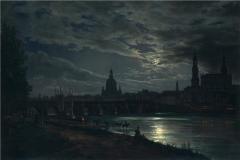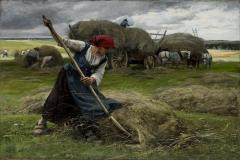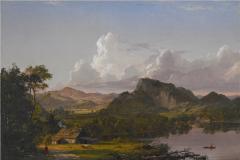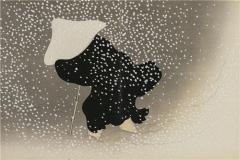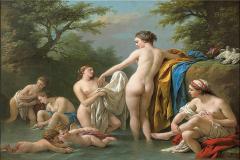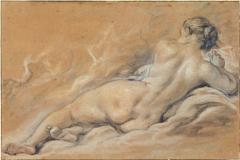调色板,画笔和纸
下面是一个列表的颜色,画笔和纸,我使用和推荐实现等效的结果,完成了玫瑰。 调色板永久的玫瑰(W&N)
永久的布朗(DS)
烧棕土(W&N)
深褐色(W&N)
镉黄(W&N)
印度黄(W&N)
刷没有。5轮,软化你的边缘
没有。6轮,以漂亮点
没有。8轮,如果你打算扩大图和在大范围内奏效
纸色基

5“×7”(12.7 cm x 17.78 cm)拱的300磅。冷榨水彩画纸
废片拱门140磅用于测试您的颜色和价值观
[1]永久玫瑰+永久的布朗(少量)(中将) [2]印度黄(中尉/地中海)。 [3]烧棕土+永久的布朗(med)。 [4]深褐色+印度黄(med)。 [5]永久玫瑰+永久的布朗(地中海/ dk。) [6]镉黄(med)。
素描
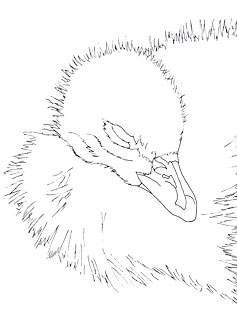
步骤1
的画底色
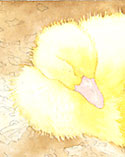
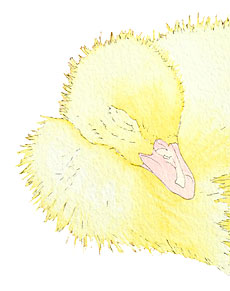

调色[1],[2]。 与你的捏橡皮擦,去除足够的石墨从丑小鸭到几乎不见的线。 喙 加载你的刷与[1]和油漆的嘴,仔细画周围的区域,需要保持白色,和软化里面边用干净湿润的刷,见图解。冲洗你的刷子和吸干好。 毛茸茸的羽毛下 鸭子头
加载你的刷与[2],从嘴、油漆向上沿眼行,至于插图显示你。把一个单独的刷装满水,污点,向上轻轻软化到头顶。让这个区域完全干燥。油漆的小区域的左边嘴以同样的方式,保持眼部很苍白的价值。让完全干燥。冲洗你的刷子和吸干好。
小鸭子的身体加载你的刷与[2]和油漆在顶部胸部停止顶部的喙。迅速采取单独刷装满水,轻轻吸干,然后收取水从你的刷成[2]。涂料组合直到你达到纤细的羽毛末尾的胸部。与[2]仍然在你的刷子,油漆大面积快速围绕喙至于图解所示,允许左边缘轻轻地电荷到水里。迅速采取单独刷装满水,轻轻地,轻轻地吸向水变成[2]。涂料用这个组合的两端纤细的羽毛的翅膀。让完全干燥。冲洗你的刷子和吸干好。
把你的刷子好点、负载与[2],和油漆所有纤细的羽毛周围的小鸭(一小部分时间)、软化下缘用干净湿润的刷。让完全干燥。步骤2
添加细节
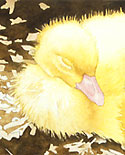
当你完成了第二步,你看起来像这只小鸭。
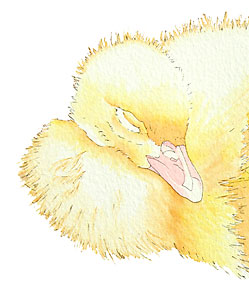
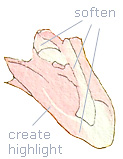
调色[1]、[2]、[4]。 喙 加载你的刷与[1],使用嘴插图作为一个指南,油漆只有那些区域如图所示,软化一些内边用干净湿润的刷。让每个区域完全干燥之前画它旁边的那只。冲洗你的刷子和吸干好。让干燥的。 毛茸茸的羽毛下 鸭子头
加载你的刷与[4],从嘴、油漆向上和沿顶部的眼行见图解。快速冲洗你的画笔涂抹,好。加载你的刷与[2],和电荷[2]到[4]。只有很短的距离画组合。冲洗你的刷子和吸干好。把一个单独的干净湿润的刷,软化向上最远的插图所示。让完全干燥。
油漆眼睛区域下。加载你的刷与[4],吸干一次,小心油漆沿顶部和周围的白色形状见图解。快速冲洗你的画笔涂抹,好。加载你的刷与[2],轻轻电荷[2]到[4]。漆一个短的距离,切换回[4]和完成在领口。迅速把一个单独的清洁滋润刷和软化所有内边。冲洗你的刷子和吸干好。让完全干燥。 小鸭子的身体油漆胸部区第一。加载你的刷与[4],和油漆一个短距离穿越了胸部。迅速采取单独刷满载[2],并收取到较低的边缘[4]。油漆下胸部很短的距离,然后软化水。重复这个在其余的胸部和下翼。电荷[2]到翅膀,和软化水的结尾。继续向上油漆,导致[2]来收取[4]。软化水。
加载你的刷子好点与[4],和油漆所有纤细的羽毛蓬松的末端沿顶部,头部、胸部、和沿背部,像过去那样在步骤1。步骤3
最后的修饰
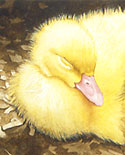
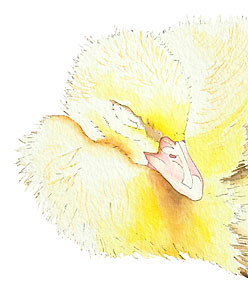
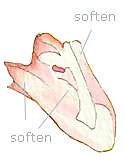
调色[1]、[2]、[3]、[4]、[5],[6]。 喙 加载你的刷与[1],漆光粉色区域,一些边缘用干净湿润刷见图解。让每个区域完全干燥之前画它旁边的那只。冲洗你的刷子和吸干好。让干燥的。加载你的刷子好点与[3]。迅速沿顶部,油漆全部的喙。保持较低的边缘滋润。吸干你的刷好。快速加载刷与[5],轻轻地冲进[3],软化后用干净湿润的边缘刷。让完全干燥。 冲洗你的刷子和吸干好。加载你的刷子好点与[5],和油漆鼻孔孔。让干燥的。 毛茸茸的羽毛下 鸭子头
加载你的刷与[6],从嘴、油漆向上和顶部眼睛线最远的插图所示。软化边缘向上,用清水洗净。让完全干燥。冲洗你的刷子和吸干好。
加载你的刷与[4],和油漆区分开的头从胸部。冲洗你的刷子和吸干好。加载你的刷与[6]和电荷成[4]。软化向上很短的距离用干净潮湿的刷。让干燥的。 加载你的刷子好点与[3],吸干,和油漆狭窄的地区在眼行,使用非常微小的笔触。 小鸭子的身体加载你的刷与[4]。油漆在胸部的顶部的喙,远下来见图解,软化水的边缘。冲洗你的刷子和吸干好。让干燥的。
油漆区直属的嘴下。加载你的画笔,[3],和油漆的小暗区见图解。不要冲洗掉你的刷子,但吸干得很好。快速加载刷与[4],轻轻地冲进周围的边缘[3]。涂料组合最远的插图所示。冲洗你的刷子和吸干好。加载你的刷与[6],并收取到左边和右边的[4]。油漆至于图解所示,软化水的边缘。 加载你的刷与[6],和油漆区域右上角的喙,软化水。冲洗你的刷子和吸干好。让完全干燥。 油漆纤细的羽毛。加载你的刷子好点与[4],和污点。把尖你刷成[2],用纤细的笔触,油漆个人羽毛在头部、胸部、和背面显示的区域。让。干。把一个单独的干净,潮湿的刷和随机软化在羽毛你只画。让完全干燥。 提示 当油漆纤细的羽毛,尽量保持尽可能的窄的线,和中风你刷向上和向下朝着自己走——不——使用一个快速的运动。尽量不要让他们直。如果你发现他们是更广泛的比你会喜欢他们,试着吸掉你的刷一次,消除一定的颜色,和/或尝试使用更轻的压力和你刷。原文如下:
Palette, Brushes, and Paper
The following is a list of colors, brushes, and paper that I used and recommend for achieving equivalent results to that of the finished rose.
Palette
Permanent Rose (W&N)
Permanent Brown (DS)
Burnt Umber (W&N)
Burnt Sienna (W&N)
Cadmium Yellow (W&N)
Indian Yellow (W&N)
Brushes
no. 5 round, for softening your edges
no. 6 round, with a nice point
no. 8 round, if you plan to enlarge the drawing and work on a larger scale
Paper
5″ x 7″ ( 12.7cm x 17.78cm) of Arches 300 lb. Cold Pressed watercolor paper
Scrap piece of Arches 140 lb for testing your colors and values
Color Key
[ 1 ] Permanent Rose + Permanent Brown (tad) (lt.)
[ 2 ] Indian Yellow (lt./med.)
[ 3 ] Burnt Umber + Permanent Brown (med.)
[ 4 ] Burnt Sienna + Indian Yellow (med.)
[ 5 ] Permanent Rose + Permanent Brown (med./dk.)
[ 6 ] Cadmium Yellow (med.)
Line Drawing
Transfer this line drawing onto your watercolor paper, enlarging or reducing it as needed.
Step 1
The Underpainting
When you are finished with Step 1, your duckling will look like this.
Mix colors [ 1 ], [ 2 ].
With your kneaded eraser, remove enough graphite from the duckling to make the lines barely visible.
Beak
Load your brush with [ 1 ] and paint the beak, carefully painting around the areas that need to remain white, and softening the one inside edge with a clean moist brush, as shown in the illustration. Rinse your brush and blot well.
Fluffy down feathers
Duckling head
Load your brush with [ 2 ] and, starting at the beak, paint upwards along the eye line, and as far as the illustration shows you to. Take a separate brush loaded with water, blot lightly, and soften upwards to the top of the head. Let that area dry completely. Paint the small area to the left of the beak in the same manner, keeping the eye area a very pale value. Let dry completely. Rinse your brush and blot well.
Duckling body
Load your brush with [ 2 ] and paint along the top of the chest stopping at the top of the beak. Quickly take a separate brush loaded with water, blot lightly, then charge the water from your brush into [ 2 ]. Paint with this combination until you reach the wispy feathers at the end of the chest. With [ 2 ] still in your brush, quickly paint the large area surrounding the beak as far as shown in the illustration, allowing the left edge to gently charge into the water. Quickly take a separate brush loaded with water, blot lightly, and gently charge the water into [ 2 ]. Paint with this combination to the ends of the wispy feathers on the wing. Let dry completely. Rinse your brush and blot well.
Take your brush that has a fine point, load it with [ 2 ], and paint all the wispy feathers surrounding the duckling (a small section at a time), softening the lower edge with a clean moist brush. Let dry completely.
Step 2
Adding the Details
When you are finished with Step 2, your duckling will look like this.
Mix colors [ 1 ], [ 2 ], [ 4 ].
Beak
Load your brush with [ 1 ], and using the beak illustration as a guide, paint only those areas as shown, softening some of the inside edges with a clean moist brush. Let each area dry completely before painting the one next to it. Rinse your brush and blot well. Let dry.
Fluffy down feathers
Duckling head
Load your brush with [ 4 ] and, starting at the beak, paint upwards and along the top of the eye line as shown in the illustration. Quickly rinse your brush and blot well. Load your brush with [ 2 ], and charge [ 2 ] into [ 4 ]. Paint only a short distance with this combination. Rinse your brush and blot well. Take a separate clean moist brush, and soften upwards as far as shown in the illustration. Let dry completely.
Paint the eye area next. Load your brush with [ 4 ], blot once, and carefully paint along the top and around the white shape as shown in the illustration. Quickly rinse your brush and blot well. Load your brush with [ 2 ] and gently charge [ 2 ] into [ 4 ]. Paint a short distance, switch back to [ 4 ]and finish at the neckline. Quickly take a separate clean moist brush and soften all the inside edges. Rinse your brush and blot well. Let dry completely.
Duckling body
Paint the chest area first. Load your brush with [ 4 ], and paint a short distance across and down the chest. Quickly take a separate brush loaded with [ 2 ], and charge into the lower edge of [ 4 ]. Paint down the chest a short distance, then soften with water. Repeat this across the rest of the chest and down the wing. Charge [ 2 ]into the wing, and soften to the ends with water. Continue to paint upwards, causing [ 2 ] to charge in with [ 4 ]. Soften with water.
Load your brush that has a nice point with [ 4 ], and paint all the wispy ends of the fluffy feathers along the top of the head, the chest, and along the back, as previously done in Step 1.
Step 3
The Finishing Touches
When you are finished with Step 3, your duckling will look like this.
Mix colors [ 1 ], [ 2 ], [ 3 ], [ 4 ], [ 5 ], [ 6 ].
Beak
Load your brush with [ 1 ], and paint the light pink areas, softening some of the edges with a clean moist brush as shown in the illustration. Let each area dry completely before painting the one next to it. Rinse your brush and blot well. Let dry. Load your brush that has a nice point with [ 3 ]. Quickly paint all along the top of the beak. Keep the lower edge moist. Blot your brush well. Quickly load your brush with [ 5 ], and gently charge into [ 3 ], then soften the edge with a clean moist brush. Let dry completely.
Rinse your brush and blot well. Load your brush that has a nice point with [ 5 ], and paint the nostril hole. Let dry.
Fluffy down feathers
Duckling head
Load your brush with [ 6 ]and, starting at the beak, paint upwards and along the top of the eye line as far as shown in the illustration. Soften the edge upwards with clean water. Let dry completely. Rinse your brush and blot well.
Load your brush with [ 4 ], and paint the area that separates the head from the chest. Rinse your brush and blot well. Load your brush with [ 6 ] and charge into [ 4 ]. Soften upwards a short distance with a clean, moist brush. Let dry.
Load your brush that has a nice point with [ 3 ], blot, and paint the narrow area under the eye line, using very tiny brush strokes.
Duckling body
Load your brush with [ 4 ]. Paint across the top of the chest to the beak, and as far down as shown in the illustration, softening the edge with water. Rinse your brush and blot well. Let dry.
Paint the area directly under the beak next. Load your brush with [ 3 ], and paint the small dark area as shown in the illustration. Do not rinse out your brush, but blot it well. Quickly load your brush with [ 4 ], and gently charge into the surrounding edges of [ 3 ]. Paint with this combination as far as shown in the illustration. Rinse your brush and blot well. Load your brush with [ 6 ], and charge into the left and right side of [ 4 ]. Paint as far as shown in the illustration, softening the edges with water.
Load your brush with [ 6 ], and paint the area to the upper right of the beak, softening with water. Rinse your brush and blot well. Let dry completely.
Paint the wispy feathers. Load your brush that has a nice point with [ 4 ], and blot. Dip the tip of your brush into [ 2 ] and, using wispy brush strokes, paint the inp idual feathers on the head, the chest, and the areas shown on the back. Let. dry. Take a separate clean, moist brush and randomly soften across the feathers you just painted. Let dry completely.
TIP
When painting the wispy feathers, try to keep the lines as narrow as possible, and stroke your brush upwards and away – not downward toward yourself – using a quick motion. Try not to make them straight. If you find they are wider than you would like them to be, try blotting your brush once to remove some of the color, and/or try using a lighter pressure with your brush.

